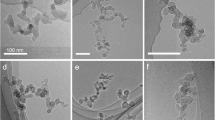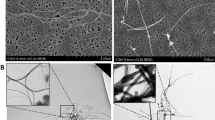Summary
Female NMRI mice aged 9–12 weeks were each given a single subcutaneous injection of 0.5 ml of a suspension containing either the total extracts or the polycyclic aromatic hydrocarbon (PAH) fraction of airborne particles. Both the total extracts and PAH fractions contain 3 Vg benzopyrene. After about 15 months the livers were removed from the animals, which had by that time developed tumors at the injection site, and were subjected to ectronmicroscopical study.
The essential alterations were observed in the nucleoli and the cell nuclei, which had greatly proliferated and exhibited irregular nuclear membranes. Advanced fibrosis was observed in central liver specimens of all groups. Marked alterations were also observed in the mitochondria and the mitochondria) cristae as well as in the bile canaliculi. Intracytoplasmic glycogen usually occurred densely clustered along the periphery of the cell.
It may be concluded from the observations that both the total extract of atmospheric suspended particulate matter and the PAH fraction cause hematogenic damage to the liver following subcutaneous injection, a finding which cannot be interpreted as metastatic carcinoma.
Similar content being viewed by others
References
Borgen A, Darrey H, Castagnoli N, Crocker TT, Rasmussen RE, Wang IY (1972) Metabolic conversion of Benzo(a)pyrene by Syrian Hamster liver microsomes and binding of metabolites to desoxyribonucleic acid. J Med Chem 16(5):502–506
Carter RL (1969) Early development of injection site carcinomas in rats. A study of tumours induced by iron dextrans. Br J Cancer 23:559
Carter RL (1970) Induced subcutaneous sarcomata. Their development and critical appraisal. In: Roe JC (ed) Metabolic aspects of food safety. Blackwell, Oxford
Chambers VC, Weiser RS (1964) Annulate lamellae in sarcoma cells. J Cell Biol 21:133
Claude A (1969) Microsomes and drug oxidation. Academic Press, New York
Contag B (1978) Die krebserzeugende Wirkung polycyclischer aromatischer Kohlenwasserstoffe. Z Naturforsch [c] 33:651–659
David H, Kettler LH (1961) Degeneration von Lebermitochondrien nach Ammoniumintoxikation. Z Zellforsch Mikrosk Anat 53:857
Elliot RL, Arkelger RB (1966) Fine structure of parathyroid adenomas with special reference to annulate lamellae and systate desmosomes. Arch Pathol 81:200
Evenson A (1961) Changes in the synthesis of desoxyribonucleic acid (DNA) and in micotic count in epidermis of hairless mice after a single application of one per cent 3-methylcholanthrene in benzene. A preliminary report. Acta Pathol Microbiol Scand [Suppl] 148:43
Fleischer M, Meiß R, Robenek H, Themann H (1979) Die altersabhiingige Wirkung polychlorierter Biphenyle auf die Rattenleber. Int Arch Occup Environ Health 44:25–43
Fleischer M, Meiß R, Robenek H, Themann H, Eckard R (1980) Ultrastructural morphometric investigations on rat liver of young and adult rats after treatment with technical pentachlorophenol (PCP). Arch Toxicol 44:243–257
Flickinger CJ (1973) Participation of endoplasmic reticulum in repair of nuclear membranes damaged by microsurgery. J Cell Biol [Abstr] 59:202
Greenawalt JW, Foster GV, Lehninger AL (1962) The observation of unusual membranous structures associated with liver mitochondria in thyrotoxic rat. Electron Microscopy 2:1–5
Keppler D, Lesch R, Reutter W, Deckers K (1968) Experimental hepatitis induced by D-Galactosamine. Exp Mol Pathol 9:279
König J, Funcke W, Balfanz E, Grosch B, Romanowski T, Pott F (1981) Vergleichende Untersuchung von atmosphärischen Schwebstoffproben aus 5 Städten der Bundesrepublik Deutschland auf ihren Gehalt an 135 polycyclischen aromatischen Kohlenwasserstoffen. Staub-Reinhalt Luft 41:73–78
Löwe H (1972) Struktur und Funktion des endoplasmatischen Retikulums der Säugetierzelle. Akademie, Berlin
Meiß R, Fleischer M, Rassat J, Themann H (1981) Studies of ultrastructural changes on rough endoplasmic reticulum induced by various kinds of intoxication in animal liver. Exp Pathol 19:263–266
Merkow LP, Epstein SM, Caito BJ, Bartus B (1967) The cellular analysis of liver carcinogenesis: ultrastructural alterations and hypoplastic liver nodules induced by 2-fluorenylacetamide. Cancer Res 27:1712
Mölbert E, Guerritore D (1957) Elektronenmikroskopische Untersuchungen am Leberparenchym bei akuter Hypoxie. Beitr Pathol Anat 117:32–49
Parson DF (1966) Membranes in endoplasmic reticulum and mitochondria. Ann Report, NY Acad Sci 137:643
Pott F, Brockhaus A, Huth F (1973) Untersuchungen zur Kanzerogenität von polyzyklischen aromatischen Kohlenwasserstoffen im Tierexperiment. Zentralbl Bakteriol [Orig B] 157:34–43
Pott F, Tomingas R, Brockhaus A, Huth F (1980) Untersuchungen zur tumorerzeugenden Wirkung von Extrakten und Extraktfraktionen aus atmosphärischen Schwebstoffen im Subcutantest bei der Maus. Zentralbl Bakteriol [Orig B] 170:17–34
Rosenbaum RM, Wittner M, Lenger M (1969) Mitochondrial and other ultrastructural changes in great alveolar cells of oxygen adapted and poisoned rats. Lab Invest 20:516
Tandler B, Hoppel CL (1980) Ultrastructural effects of riboflavin deficiency on rat hepatic mitochondria. Anat Rec 196:183–190
Umweltbundesamt (1979) Luftqualitätskriterien für ausgewählte polyzyklische aromatische Kohlenwasserstoffe. Erich Schmidt, Berlin
Vasilev JM (1959) Early changes in the subcutaneous connective tissue in rats after implantation of pellets containing carcinogenic polycyclic hydrocarbons. J Natl Cancer Inst 23:441
Westwood FR, Longstaff E, Butler WH (1979) Cellular progression of neoplasia in the subcutis of mice after implantation of 3,4-Benzpyrene. Br J Cancer 39:761–772
Zytkovicz TH, Moses HL, Spelsberg TC (1978) Competitive binding and metabolism of several carcinogenic polycyclic aromatic hydrocarbons by AKR mouse embryo cells in culture. Cancer Res 38:2307–2313
Author information
Authors and Affiliations
Additional information
This investigation was supported by the Bundesministerium für Forschung und Technologie (Federal Ministry for Research and Technology)
Rights and permissions
About this article
Cite this article
Meiß, R., Heinrich, U., Offermann, M. et al. Long-term study of liver damage following subcutaneous injection of airborne particle extracts and polycyclic aromatic hydrocarbon fractions. Int. Arch Occup Environ Heath 49, 305–314 (1982). https://doi.org/10.1007/BF00377939
Received:
Accepted:
Issue Date:
DOI: https://doi.org/10.1007/BF00377939




